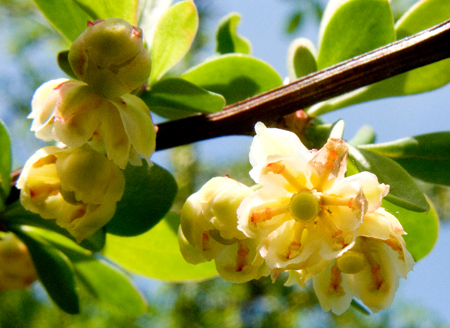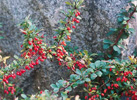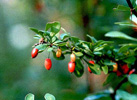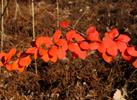Berberine, universally present in rhizomes of Berberis species, has marked antibacterial effects. Since it is not appreciably absorbed by the body, it is used orally in the treatment of various enteric infections, especially bacillary dysentery. It should not be used with Glyccyrriza species (Liquorice) because this nullifies the effects of the berberine. Berberine has also shown antitumour activity and is also efective in the treatment of hypersensitive eyes, inflamed lids and conjunctivitis.
A tea made from the fruits is antipruritic, antiseptic, appetizer, astringent, diuretic, expectorant and laxative. It is also used as a febrifuge. The fruit, or freshly pressed juice, is used in the treatment of liver and gall bladder problems, kidney stones, menstrual pains etc.
Plants can be grown as a medium-size hedge in exposed positions but they cannot tolerate extreme maritime exposure. They are very tolerant of trimming but can also be left untrimmed if required. A good quality yellow dye is obtained from the roots, bark and stem. As well as being used on cloth, it is also used to stain wood.
The unripe fruit is dried and used as beads. Wood - fine grained, yellow. Used for carving, toothpicks, mosaics etc. It is also used as a fuel.
The roots are astringent and antiseptic. They have been pulverized in a little water and used to treat mouth ulcers. A tea of the roots and stems has been used to treat stomach ulcers. The root bark has also been used as a purgative and treatment for diarrhea and is diaphoretic. A tincture of the root bark has been used in the treatment of rheumatism, sciatica etc. The root bark is a rich source of the alkaloid berberine (about 6%).
The leaves are astringent and antiscorbutic. A tea made from the leaves is used in the treatment of coughs. The plant (probably the inner bark) is used by homeopaths as a valuable remedy for kidney and liver insufficiency.
Fruit - raw or cooked. A very acid flavor, it is mainly used in preserves, though children and some adults seem to like it raw when it is fully ripe. A refreshing lemon-like drink can be made from the fruit. The fruits are about 10mm long.
Young leaves - used as a flavoring or as an acid nibble. They can be used in much the same way as sorrel (Rumex acetosa). The dried young leaves and shoot tips make a refreshing tea.



